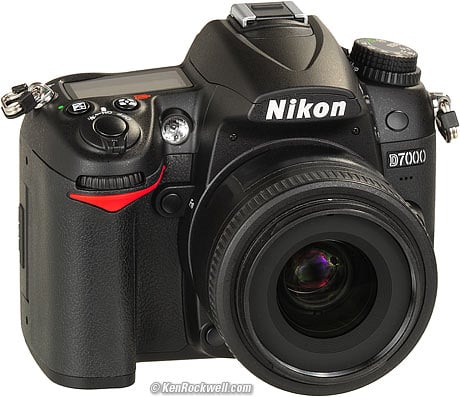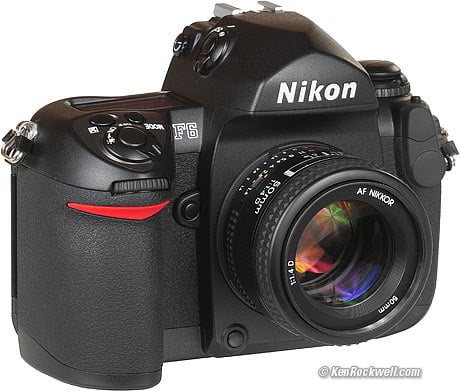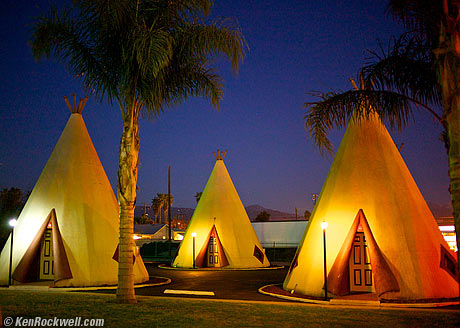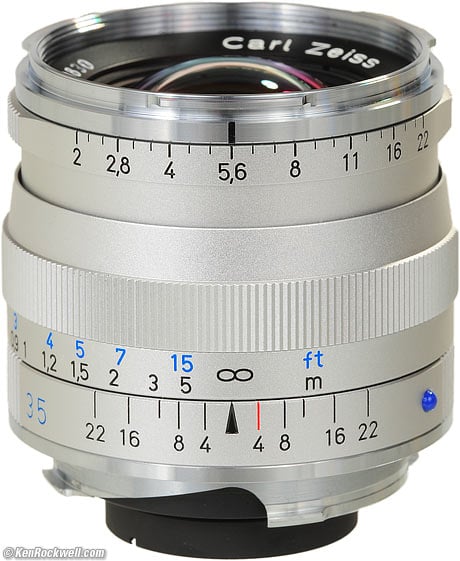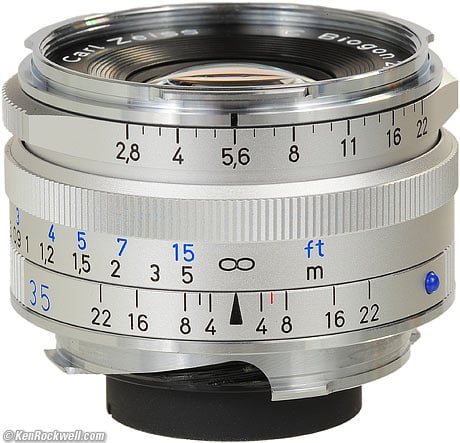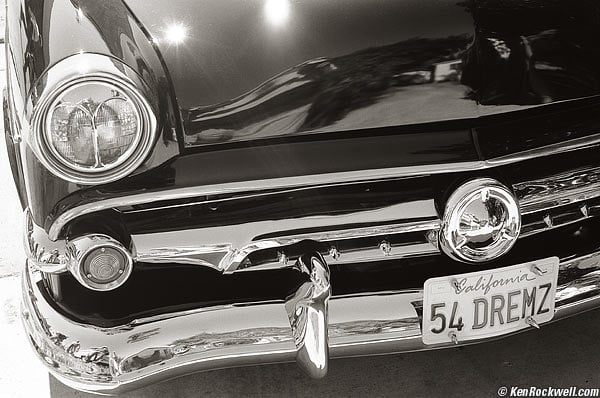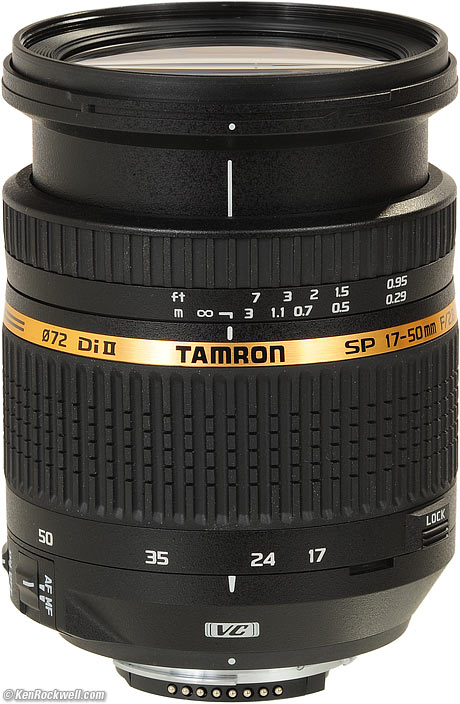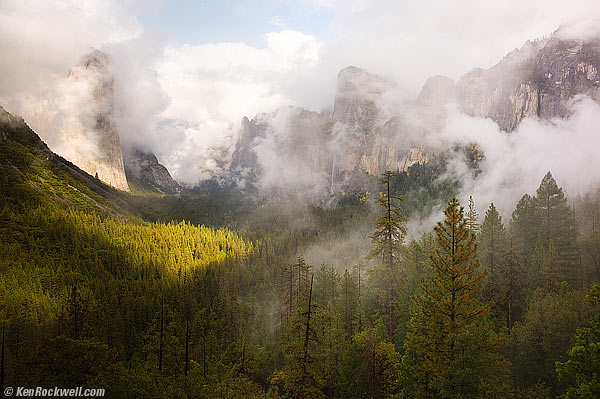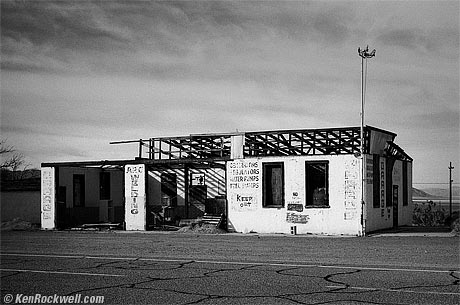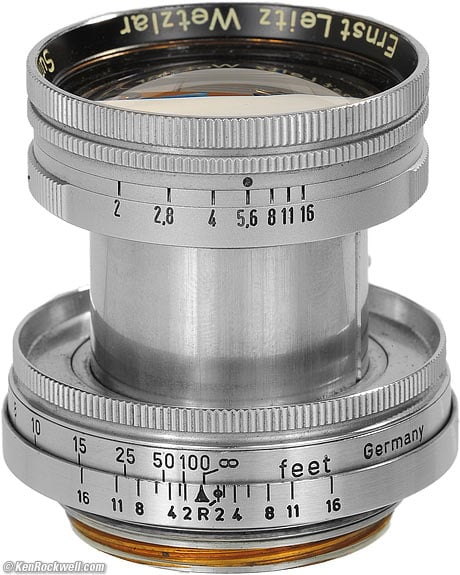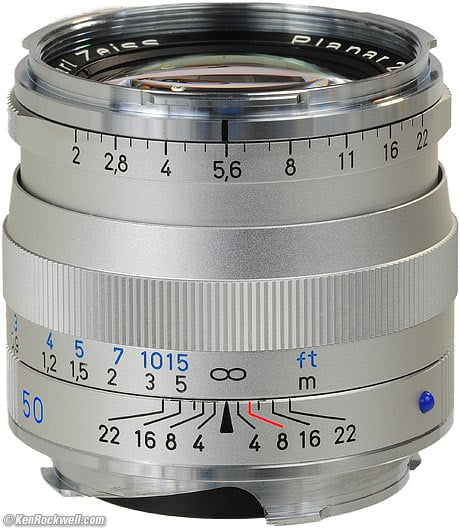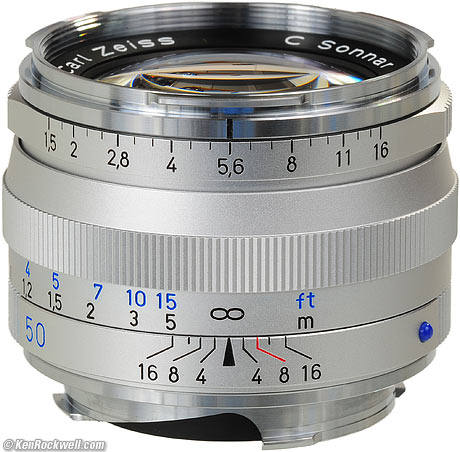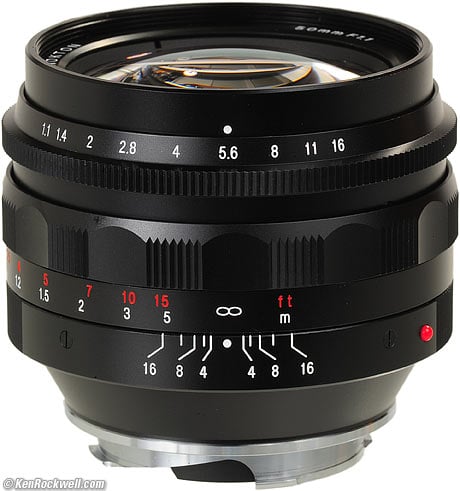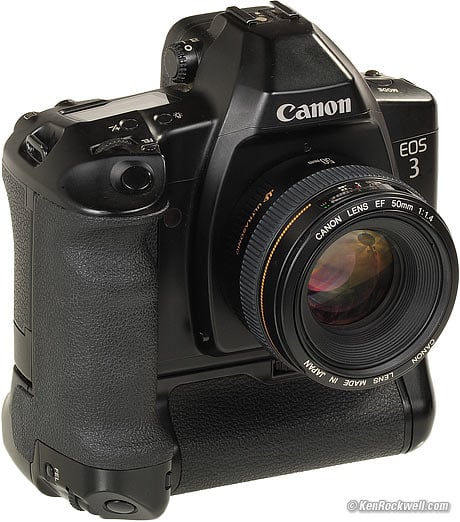Home Donate Search Gallery Reviews How-To Books Links Workshops About Contact
February 2011's Updates Hot Deals
RSS: daily (continuous live updates)
all © 2011 KenRockwell.com. All rights
reserved.
Nikon Canon LEICA More Reviews random Ryan Katie
Recommended Cameras How to Take Better Pictures
|
Adorama pays top dollar for your used gear. I use these stores. I can't vouch for ads below. |
24 February 2011, Thursday
Whoops!
I started to write-up an article on split-toning, which is how I got the warm-toned black-and-white images from last week's Route 66 tour in the Los Angeles area, but discovered I already wrote about it back in 2006.
That 2006 page was written for Photoshop CS2, so I'm still writing the new page for CS5, but have to get everything sorted out so I don't go confusing the fabric of the universe with two pages about the same thing. For instance, my How to Make Great Black-and-White from Color is also obsolete today, so I've got more writing and planning to do.
23 February 2011, Wednesday
Nikon D7000 and 35mm f/1.8 DX.
Nikon D7000 Body-only In-Stock at Adorama and at Amazon.
These sell out by the minute, so hop to it if you don't have yours yet.
22 February 2011, Tuesday
Free Videos
For we Amazon Prime members, getting free second-day shipping on everything we order just wasn't good enough for Amazon, so now, Amazon offers free unlimited, commercial-free video streaming of 5,000 movies and TV shows at no extra cost.
I've been an Amazon Prime member for years, simply because it's nice to get free second-day shipping for everything I buy from Amazon. I get it much faster than I'd ever get to a store.
The King's Bokeh
If you want to see great bokeh, go see The King's Speech.
Bokeh is how softly out-of-focus areas are rendered, not how far out of focus they are. Plenty of lenses throw things out of focus, even way out of focus, but most lenses leave disturbing and distracting artifacts.
The few lenses that render out-of-focus areas smoothly are said to have good bokeh. Few photographic lenses do this well, but by the time you've shelled out five- or six-figures for cinema lenses, they are usually pretty good. I have no idea what lenses DP Danny Cohen, BSC, used, but this article says ARRI Master Primes on 35mm film. Each of these prime lenses sells for about $20,000, or rents for about $350 a day. Danny Cohen used a whole set of them.
The whole film looks as if it was shot at T1.3, but most importantly, backgrounds and foregrounds just melt away, and never distract.
For you budding cinematographers, even the second unit had five focus pullers (the people who rack the focus in and out manually, as rehearsed).
21 February 2011, Monday
The Nikon F6.
The Nikon F6
Some people just don't get the Nikon F6, the world's best 35mm SLR. (click the 1-star ratings if my link doesn't bring you right to the customer comment on Amazon.
19 February 2011, Saturday
CQ, CQ, Plainview, Long Island New York
I have a small job for a HAM operator or someone else talented with outdoor antenna masts in Old Bethpage, NY.
If you know masts and guy wires and are local, let me know, or give me a call in my NY office at (516) 468-6300.
Thanks! Ken.
NEW: Photos from my Second Route 66 Trip.
Tee Pees, Route 66. bigger. (f/1.4 at 1/8, ISO 800, no tripod)
I had to quit at 6PM Friday night, since the wife's calling dinner, and I'm not going to be late for that!
I hope to add more tech details (like how I got the great tritones on the black-and-white prints) some other time.
I did it all in Aperture from DNGs (color) and film scans (B&W). Aperture works great with film scans, too!
I exported full-resolution JPGs from Aperture, cataloged them in iView, then processed each in Photoshop CS5 to fit your screen and add my © KenRockwell.com notice.
I also used Photoshop for the split-toning of the black-and-white.
17 February 2011, Thursday
Have I transitioned to Aperture?
I do this full-time for a living. I use about ten programs all at once to do what I do.
I use Aperture to suck out of my camera and get the basics in line.
I use iView to catalog it after I've optimized and output it from Aperture, if I'm shooting raw.
I use Photoshop CS5 to do the mechanics.
I use Dreamweaver 8 to wrap it into a website and FTP it into outer space.
I use any other software as needed.
For most people who have no need for the mechanics I use for publishing, Aperture (or Lightroom) are probably all you'd need for everything.
For me, there's no "transition," just an addition of another very powerful tool to earn a living.
DEAL: Nikon kit discounts at Amazon.
DEAL: Canon 18-135mm IS for $339.95 at Adorama (white box. 18-135mm review)
More deals.
New artist: I added Juza as another artist on my Links page.
Apple Aperture so rules
I'm having a blast prepping my shots from this past weekend on Aperture 3. The amazing thing is that no one needs any tutorials or instructional videos: I'm just playing with the program and figuring it out as I go. If I get stuck, I use the Help menu, or look on the Internet.
Easy!
I think among the reasons Aperture works so well is that it was developed not by endless betas and adding too many features requested by wankers who do nothing but play on their computers, but instead by people who understand the importance of simplicity and usability.
Aperture has exactly what I need in a simple enough form that I can figure it out.
I still haven't played with Lightroom 3 (I'd rather be watching Toy Story 3 with my son) so I really can't say, but Aperture is so brilliant that I doubt that Adobe could pull off something so brilliant and simple.
It seems like every day I find a better way to arrange my Photoshop palettes and I save that workspace, while Aperture already has a better interface right out of the box. Hmm.
In Aperture, everything is already up on my screen, while with Photoshop, it's all having to click drop-down menus or keyboard commands.
I still use Photoshop CS5 for mechanical conversions for publishing my images, but Aperture probably does all that, too.
I've been using Photoshop for about 16 years, since Photoshop 3 (that's 3, not CS3), and I even dream in Photoshop because I work in it so much. Just picking up Aperture and playing with it, it's already running faster and smoother than what I can do in Photoshop with 16 years of experience. Photoshop takes more clicks, and when you do this for a living, clicks cost me money.
Aperture rules for getting things out of your camera, selected (stacks rule, although I still haven't figured out how to narrow-down selections from a multiple viewer selection), optimized and churned out for distribution. Aperture is doing 90% of the work, with only 10% of the effort it took in Photoshop!
Oh yes — Aperture is doing all this with DNG (raw) files faster than my JPG workflow used to be!
Aperture Holy Cow #1: Double-Clairvoyant Dust removal
I discovered that once I spot-out dust in one image (just hit X and spot away), I can spot out all the dust the same way in all similar images simply by Lifting and Stamping adjustments to all the other images. The locations of all the spotting I did are copied, and the dust similarly removed!
I'm sure I could figure out how to do this in other software, but it would probably take me a year to learn it, not a minute as it does in Aperture.
Aperture Holy Cow #2: Brush Size Changes
I've never figured out how to get tool sizes to change with anything other than kludgy keyboard commands that take two hands (hit [ or ] with your left hand with your other hand on the mouse), or a Wacom tablet which I've never figured out, while Aperture's tools change size by magic right from my mouse!
Just flick the mouse's scroll doo-dad up and down, and the brush changes size!
Aperture Holy Cow #3: Clairvoyant Burning and Dodging
Here's another think that makes Aperture so much smarter and faster than Photoshop: when you do this, check the secret "Detect Edges" box. Holy cow: for the first time in the history of photography, this program makes it trivial to burn or dodge what we want, and not have watch out for the edges!
Ever since the 1800's, what took most of our time trying to do this in the darkroom or in Photoshop has been trying to stay within the lines of whatever we're trying to burn or dodge, and now Aperture keeps us where we need to be by magic!
Free HDR
If you slam the Shadows and the Highlights sliders too far, Aperture pulls everything out of the shadows, and it looks just like the awful stuff people used to call HDR.
Remember, shadows are supposed to be dark, and highlights are supposed to be light.
Technical Supremacy
Rich guys think they're cool when they open a raw file in Photoshop's Adobe Camera Raw (ACR), and spend a day jacking it in Photoshop with layers and masks.
We can do the same thing faster in Aperture, and there's a secret. I knew all this, but is became apparent why Aperture is technically better when I jammed the Shadows slider and was able to pull up black shadows that were 8 stops underexposed, with vivid detail.
When we open something in ACR, it's converting the raw data into a raster image that is then processed in Photoshop. If we open the file in 16-bits, all is well. All our adjustments made in ACR are done once, and then we have our 16-bit file to tweak in Photoshop to our heart's content.
By comparison, Aperture never makes any final conversions from the raw data until we do a final export of an edited version. Every adjustment and brush is applied to the virginal raw information only once: on export.
When a raw file is opened in Photoshop's ACR, ACR applies all our white balance, exposure, contrast, black-clip and every setting to the data, and produces a big file from it. Here's the problem with this: we always lose something in this process. Add exposure, and we lose some highlights. Open with whatever black-clip setting, and we lose some shadows.
No matter how much we screw with something in Photoshop with what started off as a raw file, we're losing information as soon as we've converted the raw data into a raster image in ACR. Photoshop can't process raw data: it needs the raster data from ACR, and ACR does all sorts of curve shaping, truncation, redithering, rounding and you name it to convert the 14-bit linear raw data into 16-bit log z-axis data. Photoshop asks you to make final decisions in ACR before you even get to start working in Photoshop with a raw file!
Contrast this to Aperture, which is always working directly from the original raw data. All the settings we apply in Aperture are calculated directly from the raw data, so if we need to add black clipping, highlight compression, severe white balance shifts, and add strong shadow recovery as well as burn and dodge, these are all calculated from the original raw data. There is no raw-conversion happening a la ACR before Aperture can read the file; the only conversion from raw happens in Aperture only on export.
Here's an example: we sharpen in ACR as part of the demosaicing, but do arbitrary rotations later Photoshop to fix an unlevel camera. ACR does all sorts of inter-pixel interpolation to demosaic and sharpen our image, and we lose more sharpness again when re-interpolating to perform the arbitrary rotation later in Photoshop. With Aperture, the raw data is never touched, so the demosaicing, rotation and sharpening are all calculated in the same conversion sequence from the original data, only on final export.
Aha!
16 February 2011, Wednesday
Zeiss Biogon 35mm f/2 ZM.
NEW: Zeiss Biogon 35mm f/2 ZM Review.
Zeiss C Biogon 35mm f/2.8 ZM.
NEW: Zeiss C Biogon 35mm f/2.8 ZM Review.
I'm Stoked
1954 Ford. bigger. (1953 LEICA IIIf, foggy 1958 LEICA SUMMICRON 50mm f/2 collapsible, f/9.5 at 1/50 metered by 1950s selenium LEICAMETER 2, NCPS process and scan.)
I just got back the two rolls of TMAX 100 from NCPS that I shot in a 1953 LEICA IIIf with vintage lenses and filters.
Whoa! Not bad for $7.90 for all the film I could shoot in three days (two rolls; the IIIf demands concentration), and a IIIf and and old screw-mount SUMMICRON cost a lot less than any Nikon DSLR.
We were out shooting 1950s cars and scenes along Route 66 in the Los Angeles area this weekend, and my results look awesome!
Screw plug-ins and computer simulations; if you want the look, just shoot the real thing. Hint: use an orange filter, and give plenty of exposure.
Hopefully I'll get to sharing some later this week. I just got back from NCPS and loaded the scans into my computer.
15 February 2011, Tuesday
Tamron 17-50mm f/2.8 VC.
NEW: Tamron 17-50mm f/2.8 VC Review.
14 February 2011, Valentine's Day
I'm back from Route 66 again, and playing with Apple Aperture 3:
NEW: How to use Apple Aperture without having to copy everything to a new library.
NEW: How to Auto-Enhance every file as it's imported to Apple Aperture.
NEW: How to get your original image files out of an Apple Aperture Library file.
11 February 2011, Friday
New Nikon Coolpix
I added links to my list below for more information on all the new coolpix, as well as where you can order them if you like.
Clearing Storm.
NEW: How to Be a Digital Ansel Adams.
09 February 2011, Wednesday
Ludlow, California, Saturday the 5th.
NEW: Route 66 Photos from last weekend.
I even included some high-resolution files from some 50-year old lenses.
I'm astounded: with Apple Aperture 3, not only did I get the best colors — by far — that I've ever seen from a LEICA M9, I taught myself Aperture and completed this entire job in a fraction of the time it usually takes me using Photoshop.
I usually take a week or two to edit and optimize everything in Photoshop.
In this case, it took just a few hours to learn Aperture, work everything through it, and bingo!, publish it. Whoo hoo!
NEW: iPod Touch Users Guide.
Here's Nikon's PR information.
We'll see what comes out in Nikon SLRs later.
Nikon COOLPIX P500:
· 36x Optical Zoom-NIKKOR ED Glass Lens (22.5mm wide-angle to 810mm super-telephoto)
· 12.1-Megapixels
· EXPEED C2 dual image processors and Backside Illumination (BSI) CMOS sensor enable high-speed continuous shooting, exceptional low-light quality and advanced performance
· Full HD (1080P) recording
· Available in March 2011 for $399.95 in Black and Red
Nikon COOLPIX P300:
· 4.2x Wide-Angle, f/1.8 maximum aperture NIKKOR glass lens (24-100mm)
· 12.1 megapixel CMOS sensor
· Backside Illumination (BSI) CMOS sensor, High ISO Sensitivity, and fast wide-angle f/1.8 lens result in superior image quality in low-light conditions
· Aperture Priority (A), Shutter Priority (S) and Full Manual (M) Controls easily accessed by the camera’s convenient Mode Dial
· Available in March 2011 for $329.95 in Black
Nikon COOLPIX S9100:
· 18x Optical Zoom-NIKKOR ED Glass Lens (25mm wide-angle to 450mm telephoto)
· 12.1-Megapixels in a deceptively thin body
· Full HD (1080p) movie recording with one-touch operation, optical zoom, stereo sound and the ability to capture still images during recording
· Huge, Bright 3.0-inch high-resolution VGA (921,000-dot) Clear Color Display
· Available in March 2011 for $329.95 in Black, Red, and Silver
Nikon COOLPIX S6100:
· 16.0-Megapixels and a 7x Optical Zoom-NIKKOR ED Glass Lens (28mm wide-angle to 196mm telephoto)
· Touch Panel operation on huge, bright 3.0-inch high-resolution LCD
· HD Movies (720p) with HDMI connectivity
· Available in March 2011 for $199.95 in Silver, Red, Black and Violet
Nikon COOLPIX S4100:
· 14.0-Megapixels and a 5x Optical Zoom-NIKKOR Glass Lens (26mm wide-angle to 130mm telephoto)
· Ultra slim (0.8-inches) camera body, with One-Touch recording and moviemaking of HD Movies (720p) with sound
· Intuitive Touch Panel operation on bright 3.0-inch high-resolution LCD
· Available in February 2011 for $179.95 in Champagne Plum, Silver, Black, and Red
Nikon COOLPIX S3100:
· 14.0-Megapixels and a 5x Optical Zoom-NIKKOR Glass Lens (26mm wide-angle to 130mm telephoto)
· Sleek camera design (0.8 inches, 4.2 ounces), 2.7-inch LCD and ISO Capability up to 3200
· Features 19 Scene Modes, including Portrait, Party, Landscape and Sunset – all of which automatically adjust camera settings to specific scenes
· Available in February 2011 for $139.95 in Silver, Red, Black, Yellow, Purple, Blue and Pink
Nikon COOLPIX L120:
· 14.1 Megapixels and a 21x Optical Zoom-NIKKOR Glass Lens (28mm wide-angle to 420mm super-telephoto)
· Advanced One-Touch HD (720p) Movie recording capabilities with Stereo Sound and Sports Continuous Shooting
· Features a 3.0-inch high-resolution HVGA (921,000-dot) LCD Color Display, Five-way VR Image Stabilization, Motion Detection and 17 Scene Modes
· AA-battery power
· Available in February 2011 for $279.95 in Black, Bronze and Red
Nikon COOLPIX L24:
· 14.0 Megapixels and a 3.6x Optical Zoom-NIKKOR Glass Lens (37mm wide-angle to 134mm telephoto)
· Incredible 3.0-inch LCD and ISO 1600 Capability
· Easy Auto Mode automatically selects the best settings for a photograph and a Scene Mode system that allows the user to choose from 16 scenes to find the best one for the situation
· AA-battery power
· Available in February 2011 for $119.95 in Red, Black and Silver
08 February 2011, Tuesday
The Nikon D7000 body is in-stock at Amazon. It is as I write this, and this will change from instant-to-instant.
Apple Aperture Trick
I was unclear last week when I discovered that Apple Aperture 3 was unique in being the only software I've ever used that could get consistently good color out of a LEICA M9.
The way I do this is to click:
Adjustments tab, Presets drop-down, Quick Fixes > Auto Enhance
I just got back from shooting an M9 along Route 66 this past weekend (we have another trip with some openings this weekend), and my results so far look great. If Nikon doesn't drop any new camera announcements on us to distract me, I hope maybe to get some image to share with you.
LEICA SUMMITAR 50mm f/2.
NEW: LEICA SUMMITAR 50mm f/2 Review.
Out with the new, in with the old!
This 60-year-old old lens is optically superior to many of today's zooms, which is why it merits our attention.
NEWS: A new formal paper published in Surgical Neurology proves that long-term cell phone use doubles cancer risk.
I told you so; i've been studying this since the 1970s when I started working in radio. Today, with everyone we know getting cancer, just what else do you think is so different from 20 years ago? It's that we've all had these little transmitters glued to our heads these past 10 years, and that cell phones operate on radio bands that just happen to be ideal for absorption by the head. Oops!
Laymen confuse the clear and present dangers of cell-phone radiation with non-risks like EMF from electrical towers and low risks from WiFi. Cell-phone companies just love to try to lump the idiots afraid of power lines along with the scientists who've proved just how dangerous is cell-phone radiation to try to keep the public fat, dumb and happy.
Electrical towers are a non-risk. Even though people in real estate call them "cancer towers," the real risk is that they are ugly, block the view, and might mess up AM radio reception if you're a HAM. In reality, very little energy comes from power lines. They are at a very low frequency (60 Hz) where very little radiates, and they usually use three-phase lines (the Tesla Polyphase system) whose fields cancel each other at a distance anyway. The power companies don't want to lose any of this power, and the fields at people's homes are usually measured in milliGauss (mG). A milliGauss is one ten-millionth of a Tesla, and when you get MRIs, you're in fields measured in Teslas. Not only is power-line field strength about one ten-millionth the magnetic field strength of an MRI, my noted radiologist college tells me that the Tesla-strength fields aren't any sort of risk anyway. They don't deliver any power into the body (it's just a static field that's not absorbed), so power lines and milliGauss fields (or the even much stronger Tesla-strength fields) are a non-issue — but laymen fear them, just like anything a layman doesn't understand.
WiFi and Bluetooth do transmit real power, transmit on the same 2.4GHz bands more or less as used by microwave ovens, and this radiation is absorbed by human tissue exactly in the same way a turkey heats in a microwave oven. WiFi and Bluetooth don't transmit much power, so they aren't much of a concern. We're happy if Bluetooth gets us a few feet reliably, and I'm ecstatic if WiFi makes it from one side of my condo to the other.
Cell phones operate on these same microwave bands, but the problem is that they have enough power to transmit many miles to cell phone base stations (towers), and worse, that many of us hold cell phones so close that they touch our heads!
Cancer isn't ever "caused;" it's a random risk just like blurry photos caused by camera shake. Our concern is doing things that increase or lessen the probability of being diagnosed with cancer, or getting a blurry picture. Do the same thing ten times, and some percentage of photos will be blurry or not, and some people will get cancer, and some won't. We're playing with probability, much as scofflaws gamble that they can get away with speeding at any particular point on the freeway.
Cancer risk is elevated by cell-phone use because the microwave power radiated from the cell-phone's transmitter is powerful enough to heat human tissue. The problem is that this heating happens in ways not expected or detected by the body's own very precise temperature-regulation systems, and we get localized heating of the brain. The body's processes are extremely dependant on precisely regulated temperatures, and when we have localized areas getting heated that the body can't correct, we increase the incidence of cancer. (Stand in the sun, and we're heated from the outside though our skin. Use a cell-phone, and you're heating your brain from the inside-out.)
These facts have been known ever since I started studying this in the late 1970s. The problem is that these cancer risks take effect over decades, not days, and that even though we know exactly how cell phones increase cancer risk, getting precise numbers on just how much they increase that risk has been elusive. To do this, we need two huge and otherwise identical samples of the population, with the only way that they differ being cell phone use. Obviously this has been difficult , which is why we haven't had any solid data — until now. This research takes money, and the people with the money, the cell-phone companies, certainly don't want anyone to know.
For you laymen, ask yourself: just how well does your cell phone company care about you? Do you look forward to talking to them? Do they treat you well? Of course not; all they are concerned about is increasing users and ARPU (average revenue per user) by keeping that lady in your outgoing voicemail message asking if you want to leave a FAX, which wastes other people's minutes. 3G providers only care about cancer risks to the extent that consumer education would lower their revenues. Cigarette companies are still selling cigarettes as fast as they can make them, just that most are sold overseas today.
Personally, my cell phone is always OFF. I'll check voicemail once a day from my land line, and if I'm in the field, I'll bring it up once a day to check messages. Otherwise, I use Line2 over my iPod Touch's WiFi connection, which works much better than a cell phone, for a lot less money, with no extra cancer risk since I'm on WiFi anyway.
07 February 2011, Monday
There's lots of news and new products from Canon this morning.
We can only hope that Nikon's announcements later this week will bring us the D700 replacement that uses the same magic found in the D7000. (The D90 and D300s are already replaced by the D7000, but I don't discount that Nikon will introduce more expensive versions of the D7000 to try to take the richer customers.)
NEW: Canon Rebel T3i.
NEW: Canon Rebel T3.
NEW: Canon EF-S 18-55mm f/3.5-5.6 IS II.
NEW: Canon 270EX II Flash.
NEW: Canon 320EX Flash.
NEW: Canon EF 500mm F/4L IS II USM.
NEW: Canon EF 600mm F/4L IS II USM.
PROTOTYPE: Canon EF 200-400mm F/4L IS USM EXTENDER 1.4x.
NEW: Canon PowerShot SX230 HS.
NEW: Canon PowerShot ELPH 500 HS.
NEW: Canon PowerShot ELPH 300 HS.
NEW: Canon PowerShot ELPH 100 HS.
NEWS: Canon makes their 60-millionth EF lens.
Compare this to Nikon, who has only made 55 million F-mount lenses.
Nikon has been making F-mount lenses since 1959, almost all of which will mount on work on almost all Nikon cameras today.
By comparison, Canon has only been making the new EF lenses (electronic motor-in-lens autofocus) since 1987. Every EF lens is compatible with every EOS camera, film and digital, including full AF and IS compatibility, with none of the "sort of" compatibility problems Nikon lenses have with many cameras.
Canon won. Canon garbage-canned all its previous SLR lenses, the FD mount, in 1987, and we all thought Canon was nuts. Obviously, by starting from scratch and making a better lens mount, Canon long surpassed Nikon in both the pro and amateur markets.
Canon has sold more lenses in less than 25 years than Nikon has sold in over 50. Oops!
From Canon, Production of interchangeable EF lenses for Canon EOS-series AF (autofocus) single-lens reflex cameras began in 1987 at the Company’s Utsunomiya Plant, and has since expanded to a total of four production facilities including Canon Inc., Taiwan; Canon Opto (Malaysia) Sdn. Bhd.; and Oita Canon Inc. in Japan. EF lenses reached the10-million-unit milestone after approximately eight and a half years in production, followed by the 40-million-unit mark in April of 2008. Due to the popularity of the EOS Digital series, production then increased and EF lenses achieved the 50-million-unit mark in December of 2009. Canon has since produced 10 million units just in 13 months and reached the 60-million-unit milestone in January of 2011.
First introduced in March 1987, along with Canon’s EOS SLR camera system, the EF lens system has over the years featured a range of innovative proprietary technologies to lead the industry. These include such world’s firsts[i] as the Ultrasonic Motor-powered lens (USM), Image Stabilizer (IS) to compensate for the effects of camera shake, Subwavelength Structure Coating (SWC) anti-reflection technology, and a super-telephoto lens that employs a diffractive optical element. Last year, Canon successfully launched the EF 70-200mm f/2.8L IS II USM, featuring outstanding optical performance and Image Stabilization.
Canon’s current EF lens lineup is comprised of 65 models ranging from super-wide-angle lenses to super-telephoto zoom lenses, catering to the varying needs of photographers from first-time users to advanced-amateurs and professionals. The Company’s diverse selection of lenses offers several features including a number of zoom options ranging from standard to super-telephoto, Image Stabilizer-equipped lenses, large-diameter lenses, macro lenses and TS-E lenses featuring a special tilt-shift mechanism allowing manipulation of image perspective and distortion. In addition, the EF 8-15mm f/4L Fisheye USM, the world’s first fisheye zoom lens, is planned for market release in March of 2011. (Canon is ignoring the Tokina 10-17mm fisheye zoom, which has been shipping for years.)
NEWS: Canon registered 2,543 new patents in 2010
This is a 15% increase from 2009, making Canon the fourth-largest US patent filer in the world. For 18 years, Canon has been in the top 5.
03 February 2011, Thursday
Hallelujah! Apple Aperture Rules!
I finally managed to get consistently good color from a LEICA M9.
Per a reader whose work looked a lot better than mine, I asked, and he was hitting the AUTO ENHANCE button in Aperture 3 from his DNGs.
I tried it, and it looks great! (Adjustments tab, Presets drop-down, Quick Fixes > Auto Enhance.)
Whoo hoo!
I have two examples in my Zeiss 50mm f/1.5 Sonnar ZM Review.
DEAL: $50 off your first ScanCafe regular scanning order. Add discount code ROCKWELLFEB when ordering. Expires 28 February.
DEAL: Olympus 7040 14MP, 7x optical, 3" LCD camera for $129.99 at Adorama.
Zeiss 50mm f/2 Planar ZM.
NEW: Zeiss 50mm f/2 Planar ZM Review.
Zeiss 50mm f/1.5 C Sonnar ZM.
NEW: Zeiss 50mm f/1.5 Sonnar ZM Review.
02 February 2011, Wednesday
Voigtländer 50mm f/1.1.
NEW: Voigtländer 50mm f/1.1 Review.
01 February 2011, Tuesday
Canon EOS 3, PB-E2 grip, and 50/1.4 EF.
NEW: Canon EOS 3 Review.
Wow, the best AF system I've used! It actually reads my mind to know what I want to focus, even before I know! It's so much better than today's systems that expect us to screw with knobs and dials to assign AF points.
What Was New in:
Help me help you
I support my growing family through this website, as crazy as it might seem.
If you find this as helpful as a book you might have had to buy or a workshop you may have had to take, feel free to help me continue helping everyone.
If you've gotten your gear through one of my links or helped otherwise, you're family. It's great people like you who allow me to keep adding to this site full-time. Thanks!
If you haven't helped yet, please do, and consider helping me with a gift of $5.00.
The biggest help is when you use any of these links to Adorama, Amazon, B&H, Ritz, Calumet and J&R when you get anything, regardless of the country in which you live. It costs you nothing, and is this site's, and thus my family's, biggest source of support. eBay is always a gamble, but all the other places always have the best prices and service, which is why I've used them since before this website existed. I recommend them all personally.
Thanks for reading!
Ken
Home Donate New Search Gallery How-To Books Links Workshops About Contact



